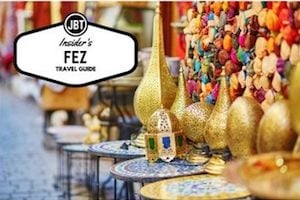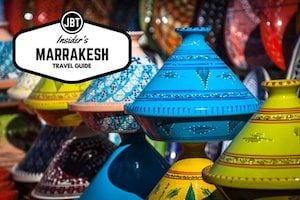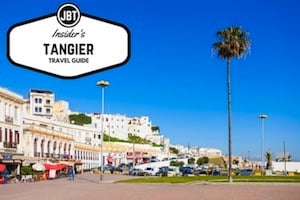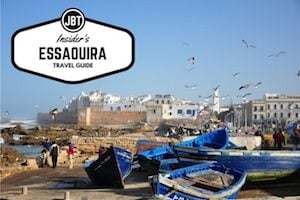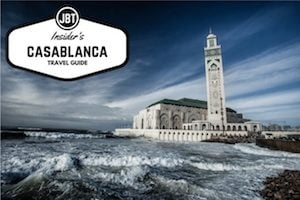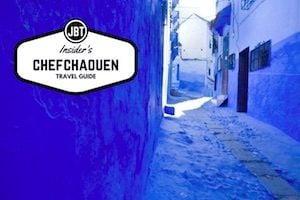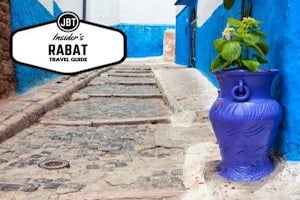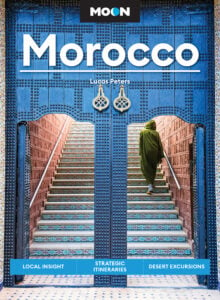
Above Bab Mansour, the imposing entrance of zelig mosaics and marble columns to Moulay Ismail’s Imperial City, an ornamental inscription boasts of the triumph of the sultan in completing this self-aggrandising homage to his vision of creating a city worthy of his rule, totally from scratch. The architect of this illustrious folly should really have learned to keep his mouth shut.

A Portuguese slave, he converted to Islam and took the name El-Mansour, ‘the victorious’ (hence the name, Gate of the Victorious), but when Moulay Ismail asked him if he could have made the gate more beautiful and he said yes, the sultan had him put to death – which just goes to show, be very wary how you answer a short-tempered ruler who is known for lopping the head off anyone who upsets him. However, historical records show that the gate wasn’t actually completed until 1732, five years after Moulay Ismail departed this mortal coil, but why spoil a good yarn just because it deviates from fact?
Place el Hedim, the large square in front of Bab Mansour, was originally the forecourt to Moulay Ismail’s palaces. The story goes that the sultan demolished the houses in the western corner to make way for a grand entrance to his palace quarters, but it was also used as storage for the construction materials he pillaged from around Morocco, most notably from the nearby Roman ruins of Volubilis, which accounts for the literal translation of the square as ‘square of demolition and renewal’. It also served as a public arena for the regular executions for those who displeased him, most notably slaves or at least those who had looked at him the wrong way and weren’t dispatched immediately.
According to legend, Moulay Ismail had 30,000 people killed during his reign, so it comes as no surprise to hear of his comment, ‘My subjects are like rats in a basket, and if I don’t shake the basket, they will gnaw their way out.’
It’s well recorded that Moulay Ismail was the most tyrannical of all Moroccan sultans, but he was also an extremely able ruler, fighting off the Ottoman Turks and chasing the British and Spanish from their coastal enclaves, firmly establishing Morocco’s independence.
His 55-year rule, from 1672 to 1727, was the longest in Moroccan history and is regarded as one of its greatest. Moulay Ismail ascended to the throne at the age of twenty-six after the death of his brother from falling from a horse , inheriting a country weakened by tribal warfare. His first act was to move from Tafilalt, a town hanging on the edges of the Sahara, to Meknes with the intention of creating a magnificent imperial city to equal Versailles, which was also under construction at the time. (He later became a close ally of Louis XIV and is sometimes compared to the French ruler due to his reputation as a warrior king and his love of grandeur).
Meknassa al-Zitoun
Previously known as ‘Meknassa al-Zitoun’ (Meknes of the olives) because it was built on a vast plain of olive groves, the town had  been settled six centuries earlier by the Berber Meknassis tribe. Moulay Ismail’s Meknes grew, built on the back of captives taken from his military forays into Mauritania and Algeria. It was supplemented by Christians taken by the piratical Sallee Rovers who sailed their sorties into European waters as far north as Iceland, and partially financing his extravagant plans by ransoming the European slaves for enormous sums. He staved off rebellion with an army of 16,000 West African slaves called the Black Guard, an elite corps whose number increased ten-fold during his reign thanks to the provision by the sultan of a decent life (at least in standards of the time) and women.
been settled six centuries earlier by the Berber Meknassis tribe. Moulay Ismail’s Meknes grew, built on the back of captives taken from his military forays into Mauritania and Algeria. It was supplemented by Christians taken by the piratical Sallee Rovers who sailed their sorties into European waters as far north as Iceland, and partially financing his extravagant plans by ransoming the European slaves for enormous sums. He staved off rebellion with an army of 16,000 West African slaves called the Black Guard, an elite corps whose number increased ten-fold during his reign thanks to the provision by the sultan of a decent life (at least in standards of the time) and women.
Coming from a culture of fierce battles and long sieges to decide sovereignty, this shrewd sultan took precautions to ensure that he ended his reign in old age. The four hectare Bassin de l’Agdal, these days a favourite of city folk to take the air on steamy evenings, was built to irrigate the Royal Gardens and as somewhere for the harem of (so it’s said) five hundred ladies to promenade, but also as a reservoir for times of siege. The second most important element of survival, food, was taken care of by the Heri es Souani, a gigantic system of cool, high-vaulted chambers for storing grain, as well as hay to feed Moulay Ismail’s 12,000 horses. An intricate network of wells fed by channels from the Agda watered the horses. A major part of the granary is in ruin, but sufficient has been restored to tempt Martin Scorsese to use it as a backdrop for The Last Temptation of Christ.
The Mausoleum of Moulay Ismail
 By the time of his death in 1727, Moulay Ismail had completed a city wall forty-five kilometres long with twenty gates surrounding more than 50 palaces. But despite his obsession with creating the ‘Versailles of Morocco’, he never succeeded in making Meknes the great imperial city of his aspirations. His demise signalled the beginning of the end of Meknes as the country’s first city, and in less than 30 years his grandson, Mohammed III, had transferred the capital of the kingdom to Marrakech.
By the time of his death in 1727, Moulay Ismail had completed a city wall forty-five kilometres long with twenty gates surrounding more than 50 palaces. But despite his obsession with creating the ‘Versailles of Morocco’, he never succeeded in making Meknes the great imperial city of his aspirations. His demise signalled the beginning of the end of Meknes as the country’s first city, and in less than 30 years his grandson, Mohammed III, had transferred the capital of the kingdom to Marrakech.
To ensure that the grandeur of his final resting place equalled that of the city he spent the greater part of his life creating, Moulay Ismail built his mausoleum while still alive, (and, curiously, positioned only a few strides from the dank dungeon where his tens of thousands of slaves passed their miserable lives when they weren’t working on their megalomaniac master’s dream).
Nondescript from the outside, the tomb containing the sultan’s remains is approached through a series of tranquil courtyards painted in warm canary yellow. Only Muslims may enter the tomb itself, but its anteroom is a delight of marble columns and soaring arches, the walls decorated in finely carved plaster and glowing with exquisite zellij tiles and enamel-painted woodwork. As a mark of respect you are required to remove your shoes before entering, but the feel of your feet on the grass mats that cover the floor is part of the sensation of peacefulness that inhabits the building. The tyrant’s strict observance of orthodox Islamic ritual weighs heavily in his favour, and many Moroccans see the Mausoleum as a place of pilgrimage to ensure health, well-being, and luck.
Meknes is one of the four Imperial Cities of Morocco, and while Rabat may have prospered as the nation’s Capital, with Fez and Marrakech drawing the bulk of visitors seeking the colourful and exotic, sleepy Meknes deserves more than simply being thought of as staging post between experiences. Its mosques, madersas and museums rival any of its more popular sisters. But there again, sometimes being the runt of the litter can have its benefits; a café chair available to watch the goings on in Place el Hedim or space to stroll the souk without crush.
Ready to Make Memories in Meknes?
If you’re ready to discover the relics and modern day life in Meknes, contact us today! Several of our itineraries include a stop in this Imperial City, or we can create a customized tour highlighting the cities and experiences you want to explore in Morocco. We guarantee you’ll have a once-in-a-lifetime adventure with our team.
Photos from: txikita69. -AX-, skittledog, pietroizzo

